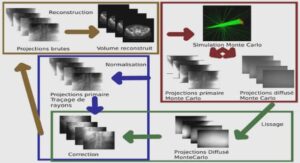Noise in power converter is an important topic which has been extensively researched. Typically, there are two types of noise mentioned in power converter researches:
– Electromagnetic Interference (EMI): noise generated by the converter, propagating to the grid, which impacts other circuits or device’s operation. To limit these effects, EMI of each power converter must be controlled under certain levels given by standards such as FCC, CISPR11, CISPR22, IEC61000-4, MIL-STD-461, etc;
– Noise immunity: the noise picked up by the converter from the other circuits or devices in the grid, affecting the converter’s performance. The converter must be designed to prevent this noise to degrade its performance.
Both types of related to the interactions between the power converter and other devices. On the other hand, there is another kind of noise inside the power converter, which can degrade the performance of control circuits. It is the noise in the low power circuit of the power converter. This noise results from the switching transients of power transistors. This noise type is not well addressed in literature, hence, it remains a difficult topic with multiple relating sub-topics for research. In order to fulfill this lack in literature, the problematic of this type noise will be introduced in the next sections of this chapter and the sub-research topics will be presented in the remaining chapters of this thesis.
Noise propagation in the low power circuit is an important factor which impacts performance and reliability of power converters, as pointed in the previous chapter. A complete research on this area should consist of defining noise sources, analyzing propagation paths and developing noise mitigation techniques. Inspite of a deep litterature review, this topic has not been well covered in literature.
First, since converter design is indeed practical, we can start with the practical design guidelines summarized by the experience designers and component manufacturers. However, the know – how is not proven by mathematical models. This fact can lead to improper design in specific cases requiring more design iterations with high cost and time consuming. Thus, the computational model for each part of the circuit is mandatory to guarantee good design in term of noise minimization. This is the general motivation of the research presented in this thesis. We not only follow the fundamental design guidelines as practical designers, but we also research on the mathematical models of the circuit. It helps to understand for which cases guidelines are applicable or not and further improve them. As general speaking, we try to improve the practical guidelines by providing their bases of theories and computation. The computational models, as introduced previously as research objectives, can be researched by applying knowledge of relevant topics as below.
– Noise source analysis, filter design and mitigation techniques can be studied based on knowledge in the area of EMI modeling of high power circuit;
– PCB structure models can be referred to area of microwave researches which are conducted for high frequency applications;
– Some specific PCB structure models can be extracted by computational softwares.
Even though the outcomes of these studies are very useful, they are not directly applicable to our main research topic due to different objectives and applications. Since these topics are identical, it is more convenient to present their comprehensive reviews in the relevant chapters. In the next sections of this chapter, we will summarize the literature at high level to provide the overall view of related research areas, how they are useful to our research and what are the limits making them not directly employed to the main research topic.
Practical design guidelines
The know – how to design low noise power converter is represented by the practical design guidelines. These guidelines are introduced in design handbooks (Johnson et al., 1993; Salman & Friedman, 2012; Horowitz & Hill, 1989) and manufacturer’s documentations (TI, 2001, 2015). These guidelines provide excellent practice for high speed signal integrity such as: routing laws for gate driver, supply and ground planes in mixed – signal PCB, use of decoupling capacitors and ferrite beads, and so on. However, these suggestions are not based on mathematical model, so it is difficult to employ in specific cases. Below are some examples:
1. Ferrite beads are suggested to prevent high frequency noise arriving at the victim circuit in high frequency. The ferrite bead impedance is the sum of its resistive and inductive parts. In case that the victim circuit has capacitive impedance, the total impedance of ferrite bead and victim circuit is represented by the resistive part at the resonant frequency created by the capacitive and inductive parts (serial LCR circuit). So, which ferrite bead impedance curve should be used to avoid noise amplification in a certain frequency range? Where will noise propagate if it is blocked from the victim circuit?;
2. In order to supply a circuit, a low power rails with power/ground plane structure is used to connect that circuit and the source. It is to minimize the impedance between these two circuits, preventing voltage spikes on the target circuit. EMI attenuators such as decoupling capacitors and filters are used to further attenuate noise. Usually, the decoupling capacitors are distributed along the low power rails and the filters are connected directly to the circuits. However, how to distribute decoupling capacitors on the low power rails? Which value of the capacitors should be used for a specific converter structure (different power transistors and layout of low power circuit lead to different noise frequencies, and hence, different values and locations of decoupling capacitors)? Which filters should be used? How impedance of the filter interact with that of the low power rails? Can it ensure noise attenuation or result in noise amplification in certain frequency ranges? These issues become more complex in case that numerous circuits are placed on the low power rails.
Research of EMI in high power circuit
EMI in high power circuit of power converter has been the essential research topic over the last ten years. Several efforts have been made to obtain EMI prediction for a whole power converter (Espina et al., 2011; Rondon-Pinilla et al., 2014; Ferber et al., 2013; Zhai et al., 2015; Ardon et al., 2010; Musznicki et al., 2013; Mrad et al., 2013). In addition, in order to meet conducted EMI standards, passive and active EMI filters are used to attenuate noise. They have been improved in terms of frequency response (Raggl et al., 2010; Akagi & Shimizu, 2008; McDowell & Hubing, 2015; Shin et al., 2015) and density (Biela et al., 2009; Maillet et al., 2010).
These researches provide the insights of noise origin, EMI analysis, and EMI filter. These knowledge are the proper basics for conducting research on EMI in low power circuit. However, they are not always valid to employ directly in board level due to the following reasons.
1. On board level, CM and DM are not well – defined and separated as in high power circuit due to multiple propagation paths provided by PCB structures and components. Thus, CM and DM models of the filter developed for high power circuit are not valid in low power circuit;
2. In high power circuits, EMI model of a complete converter can be the summary of several parts whose impedance can be measured directly (Zhai et al., 2015). This approach is valid since each part can be considered as a two – port circuit. However, at board level, the low power rails is a multi-port circuit. Hence, which impedance can be used to compute noise propagation while there are plenty of the port – to – port impedance? Since impedance is not effective to evaluate noise propagation, what can be used?;
3. In high power circuit, EMI attenuation is mostly focused on EMI filter design to comply with standards. Therefore, EMI filter is designed with the only purpose of preventing noise to propagate to the input of the converter. However, in low power circuit, the situation is more complicated. Since noise always propagate on the low impedance paths, increasing impedance at one port by the filter can result in noise increasing at the other ports of the circuit. Therefore, “where should we block noise and where should we let noise propagate to?”. This is a challenge that designers must face. Such difficulties clearly show that care must not only be taken in the local design, but also the complete circuit.
INTRODUCTION |





